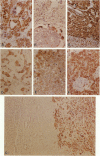Abstract
The role of p53 in the pathogenesis and progression of Wilms' tumors is only partly understood. Although p53 mutations were initially reported only in anaplastic Wilms' tumors, we had reported that, of two of twenty-one cases that had a p53 mutation, one tumor showed no evidence of anaplasia. To determine the significance of p53 expression in all clinical stages of Wilms' tumor, twenty-eight cases were analyzed for p53 immunoreactivity. Paraffin sections were immunolabeled with two different monoclonal antibodies, recognizing both mutant and wild-type p53. Fifteen of sixteen tumors in the recurrent/metastatic group and three of twelve tumors in the nonmetastatic/nonrecurrent group showed p53 immunopositivity. Only one of three positive tumors in the latter group showed moderate to strong positivity, whereas twelve of sixteen metastatic/recurrent tumors revealed a similar degree of p53 positivity. The positivity was stronger in the metastasis/recurrences as compared with the corresponding primary tumor. Western blot analysis revealed p53 expression in all of the Wilms' tumors tested, suggesting its involvement in the development of Wilms' tumors. Single-strand conformation polymorphism analysis performed on twenty-three of these tumors revealed p53 mutations in four of fourteen recurrent/metastatic tumors and none in the nonmetastatic/nonrecurrent group. Our results show that, whereas 60% of cases were immunopositive for p53 protein, mutations were detected in only 16% of tumors, indicating that wild-type p53 protein is retained in the other tumors. We conclude that p53 immunopositivity strongly correlates with recurrence/metastasis in Wilms' tumors. Furthermore, the accumulation of p53 in these tumors is not only due to mutations but may also involve stabilization of normal p53 with other proteins.
Full text
PDF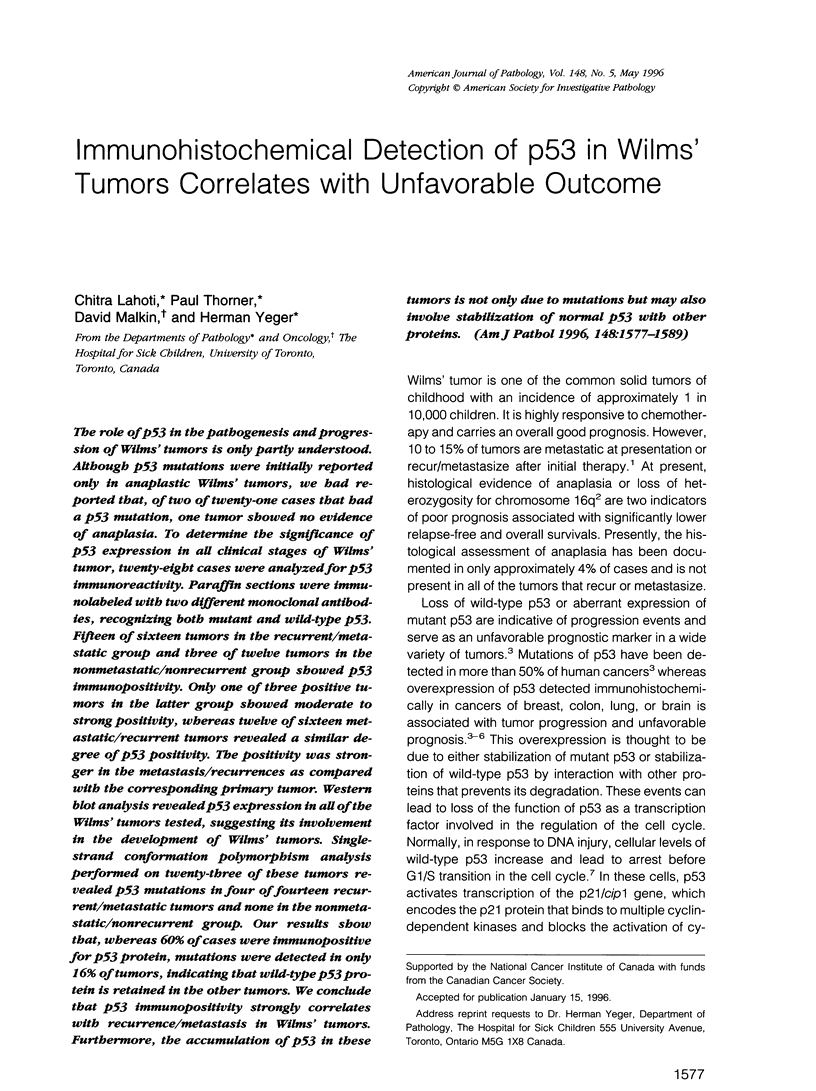
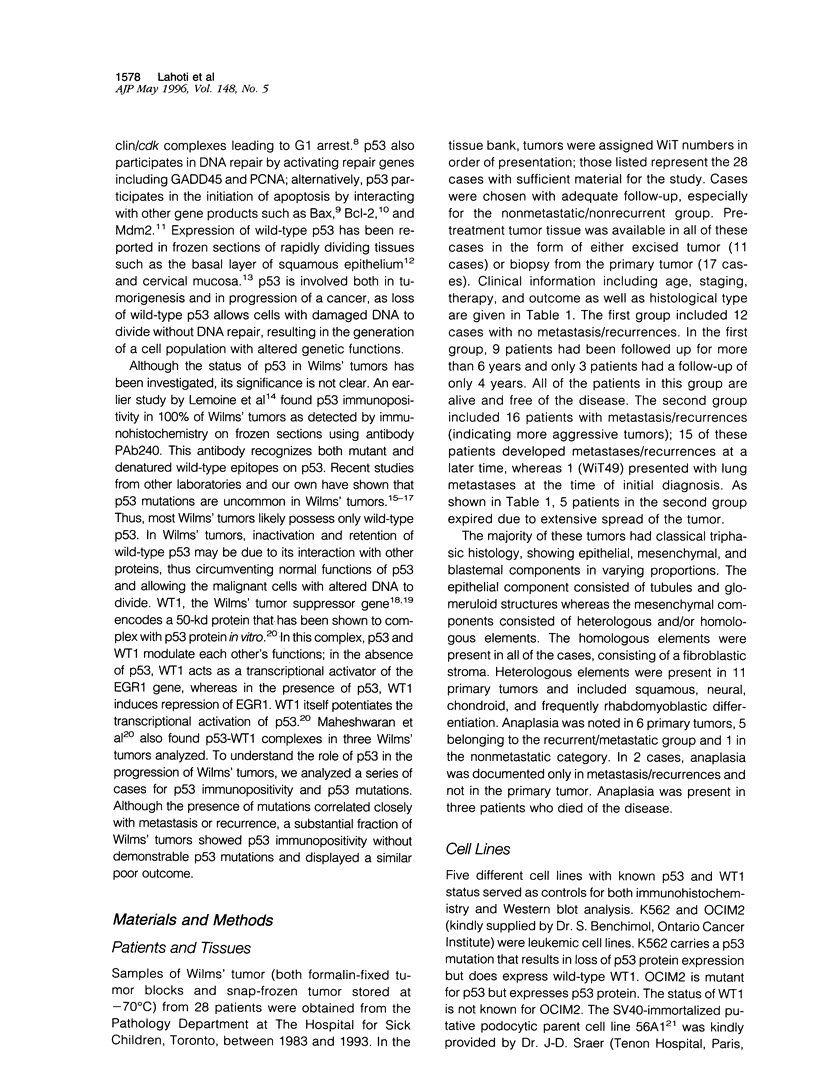
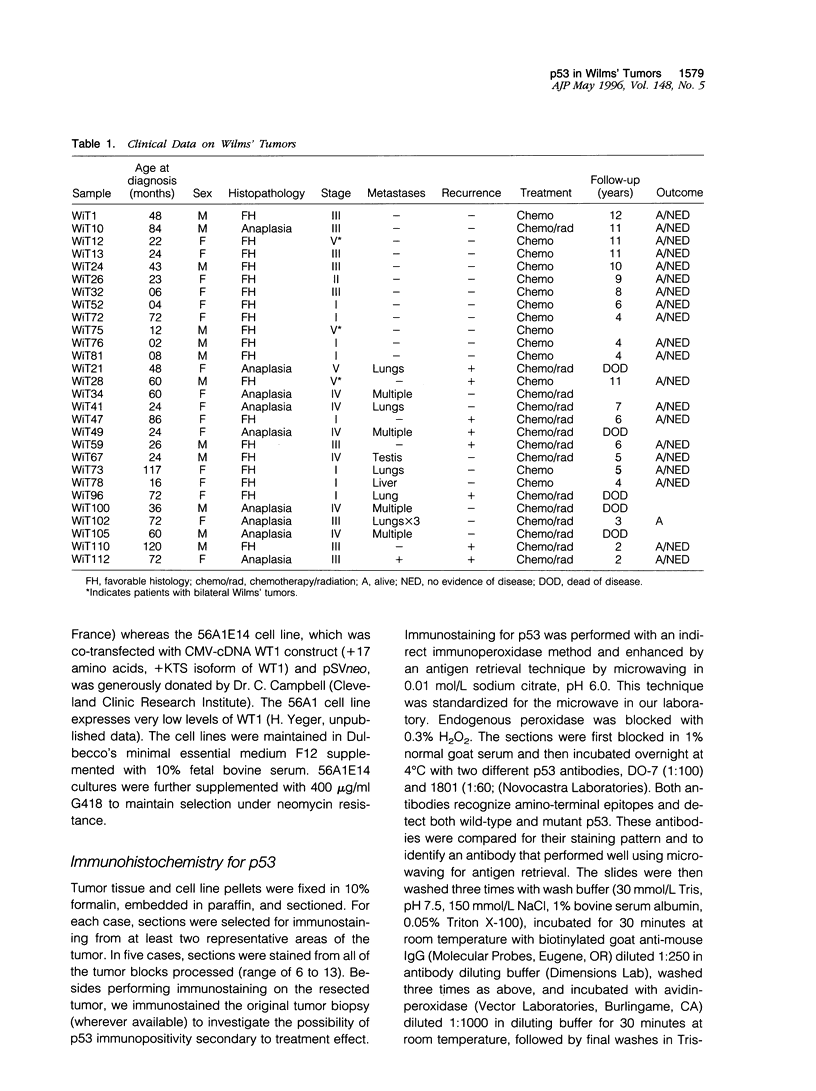
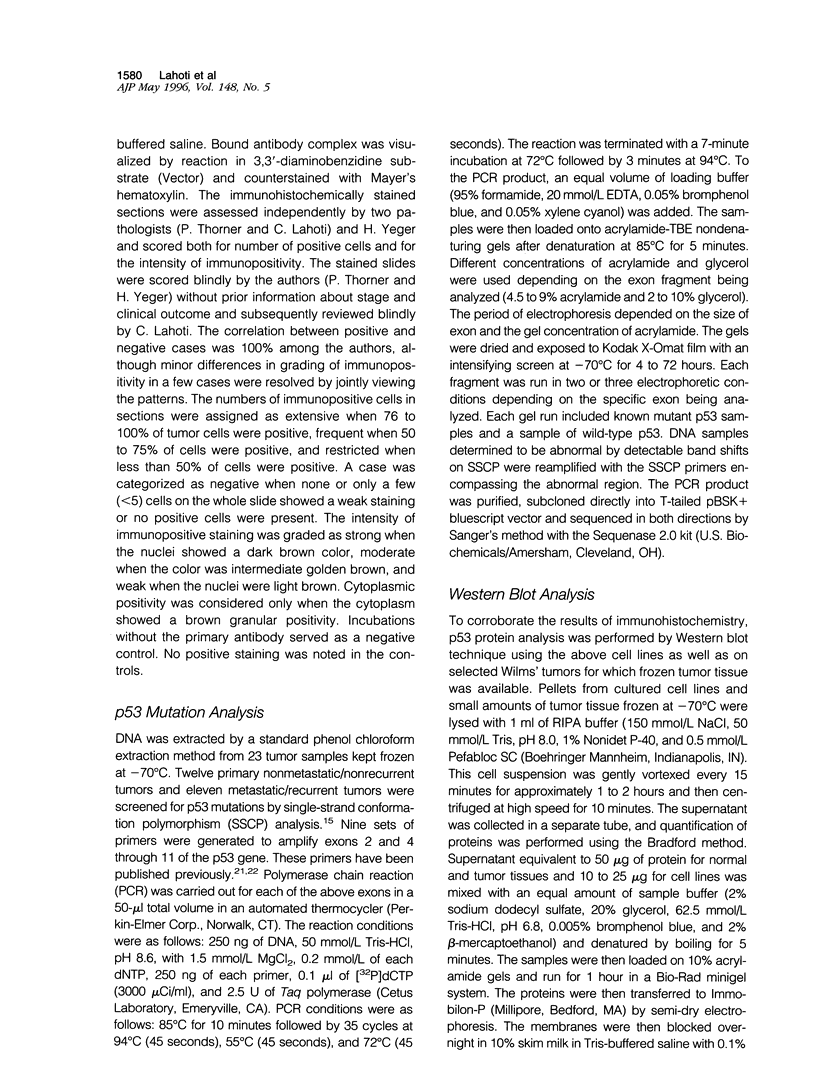
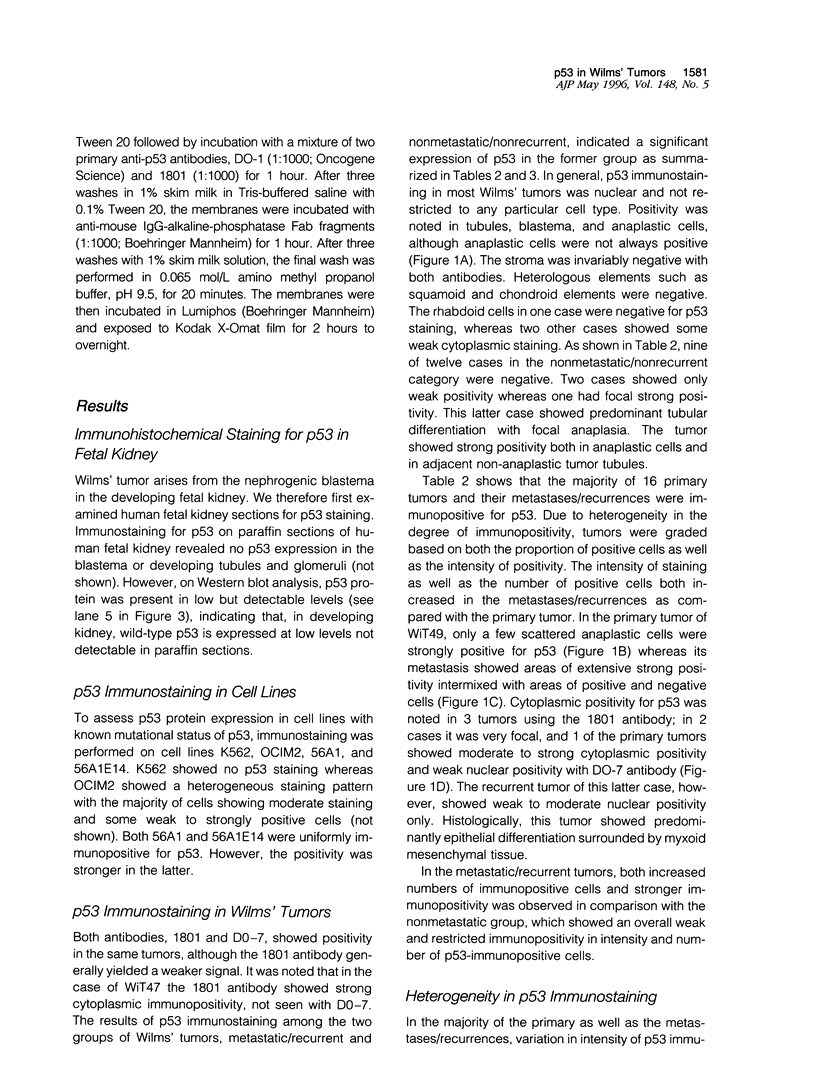
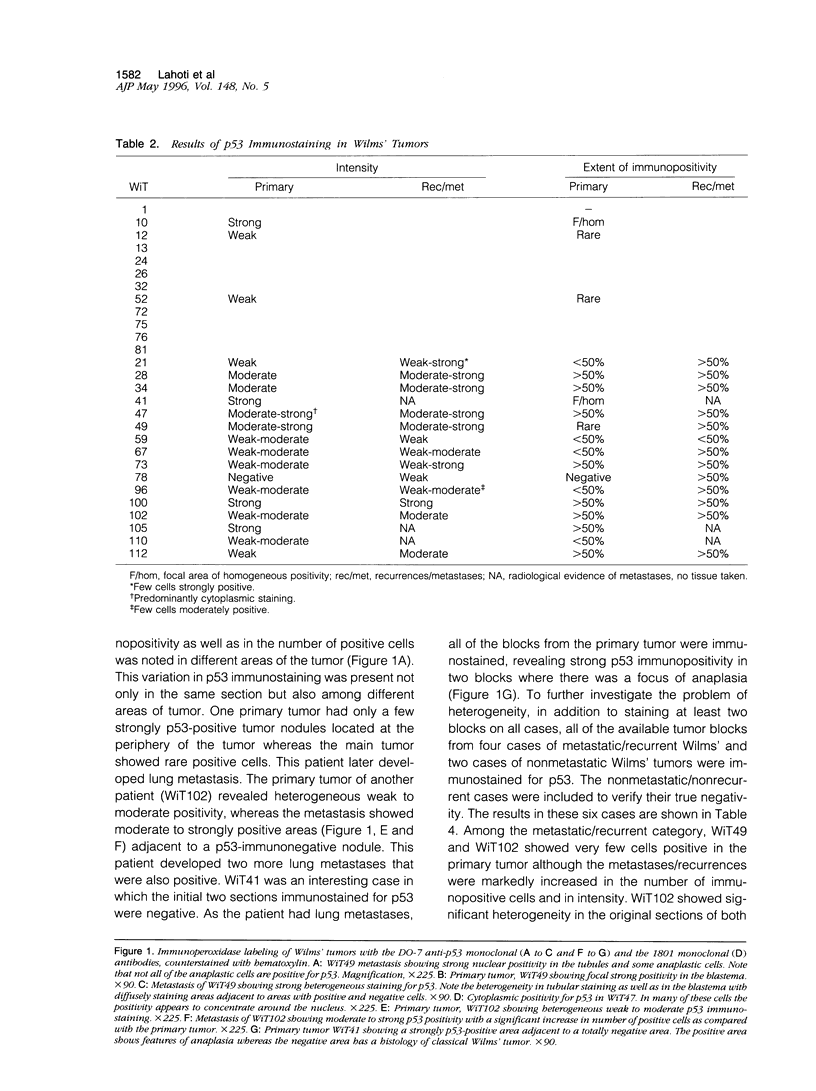
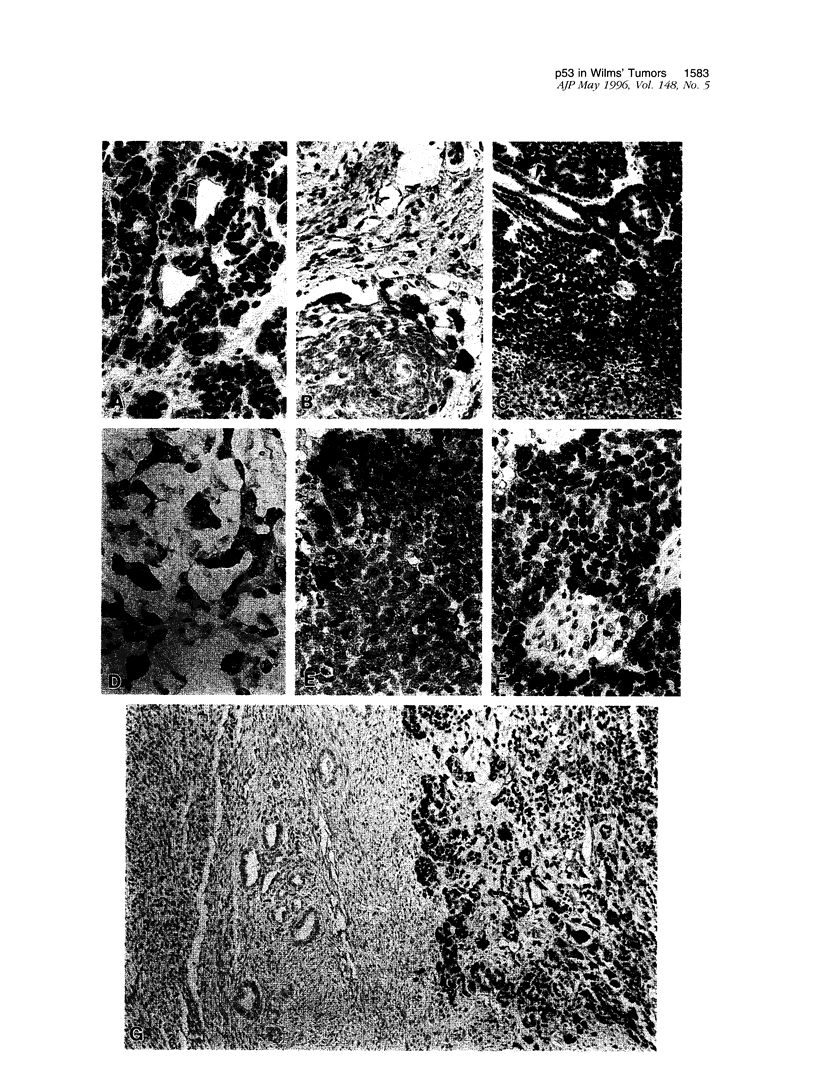
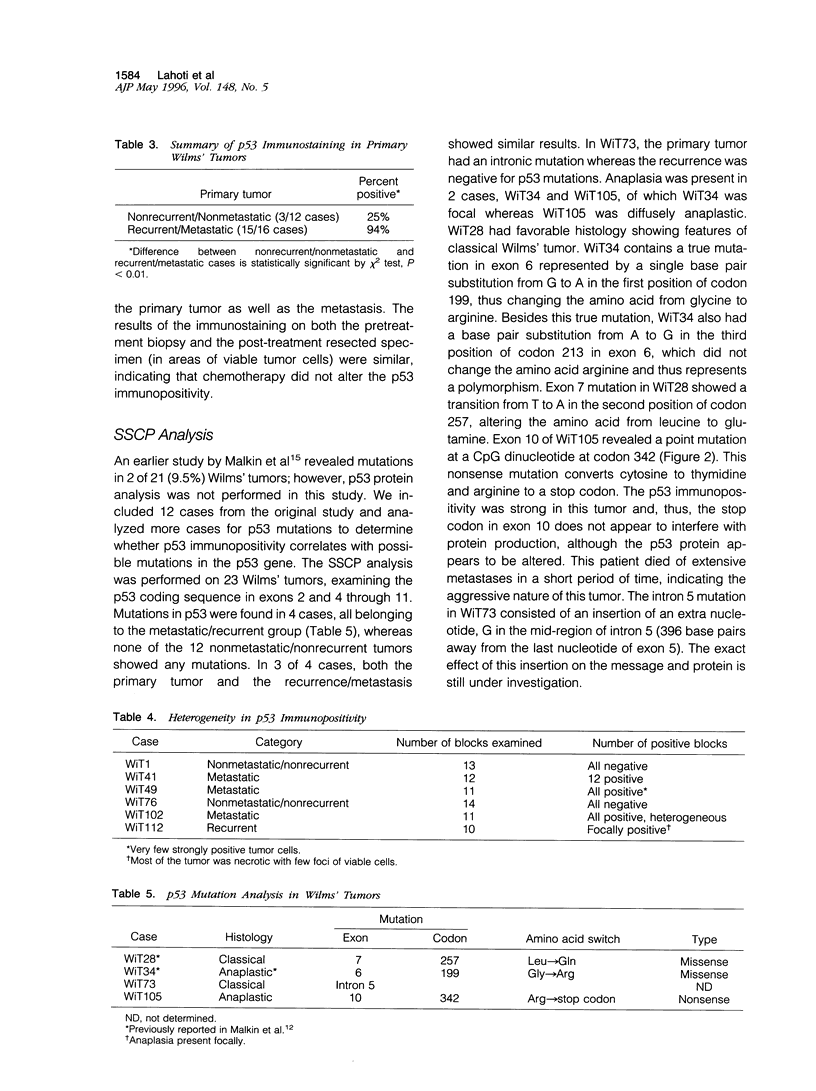
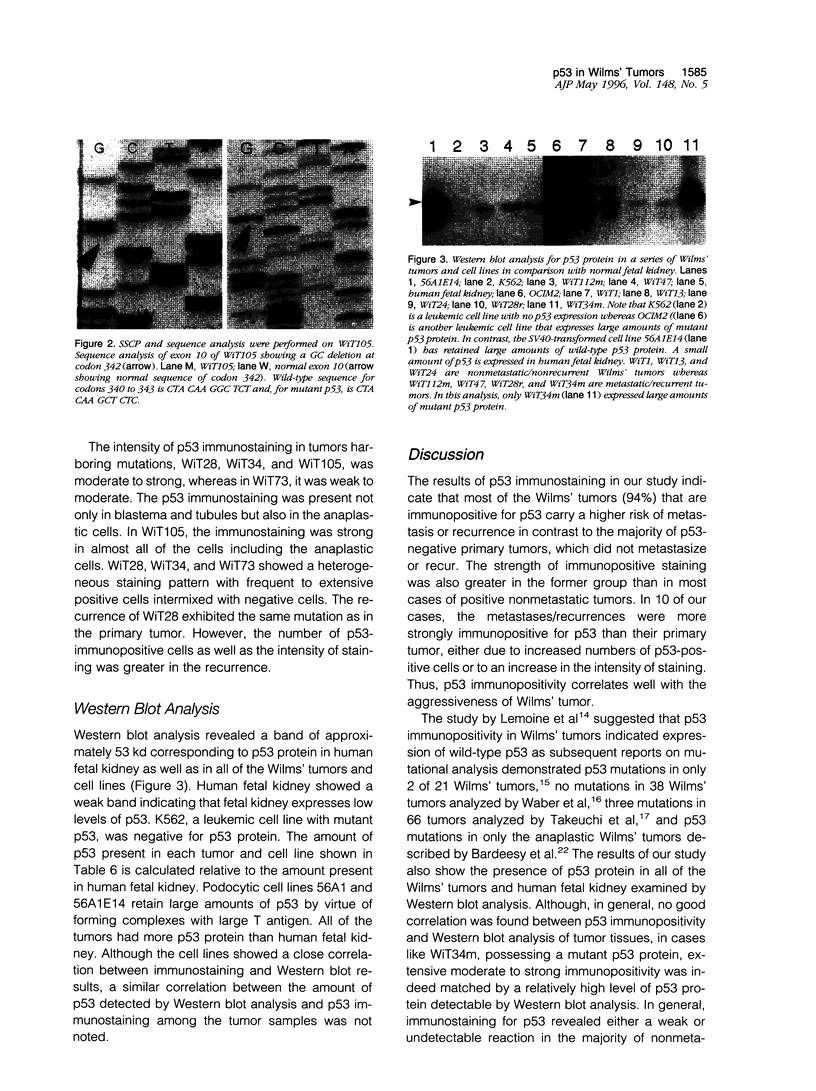
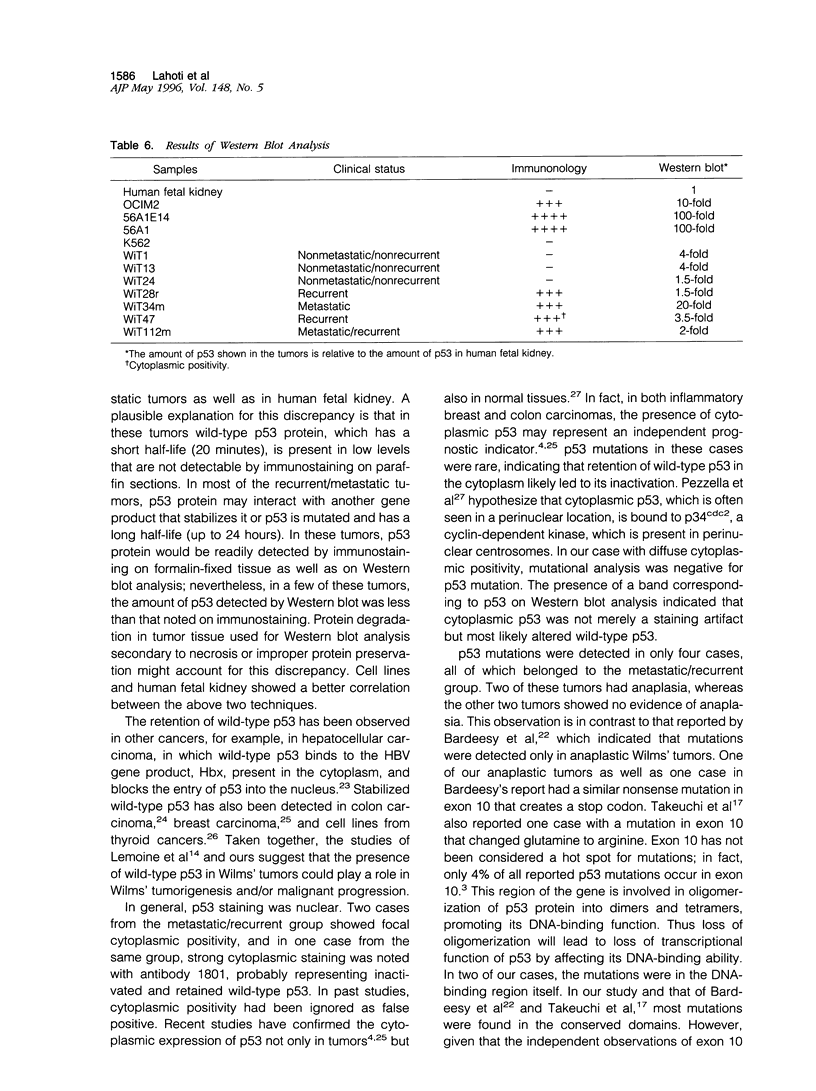
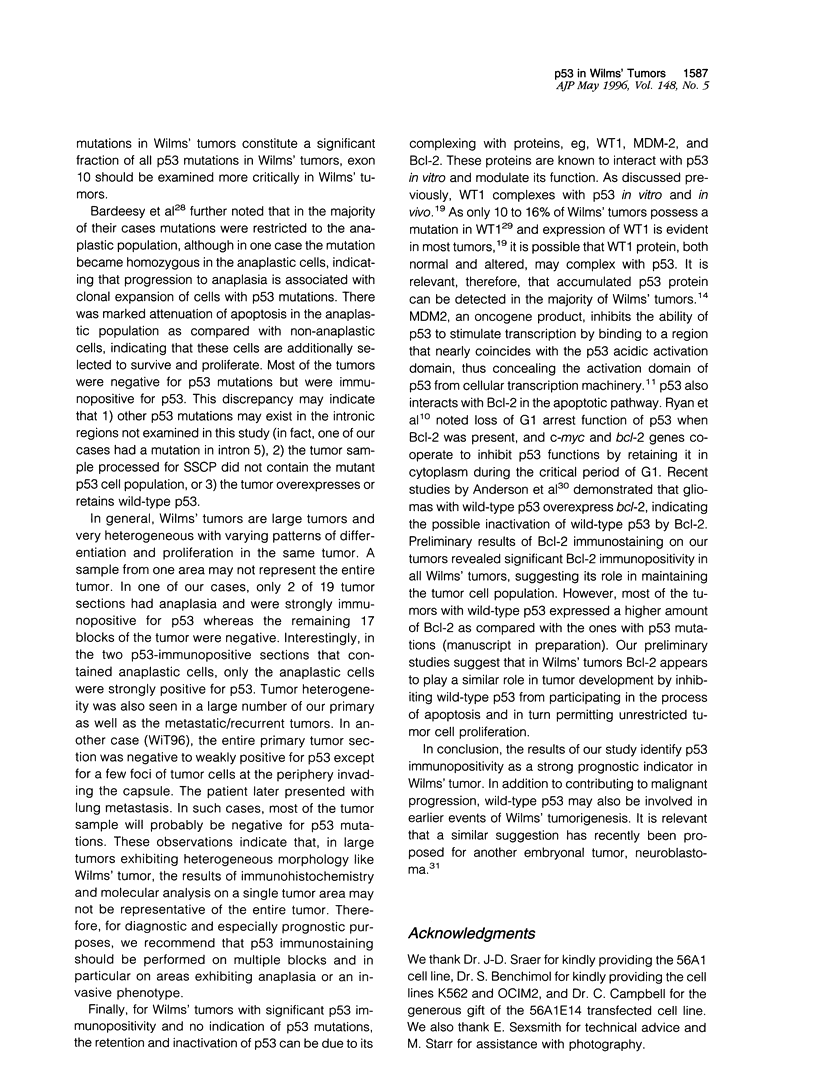
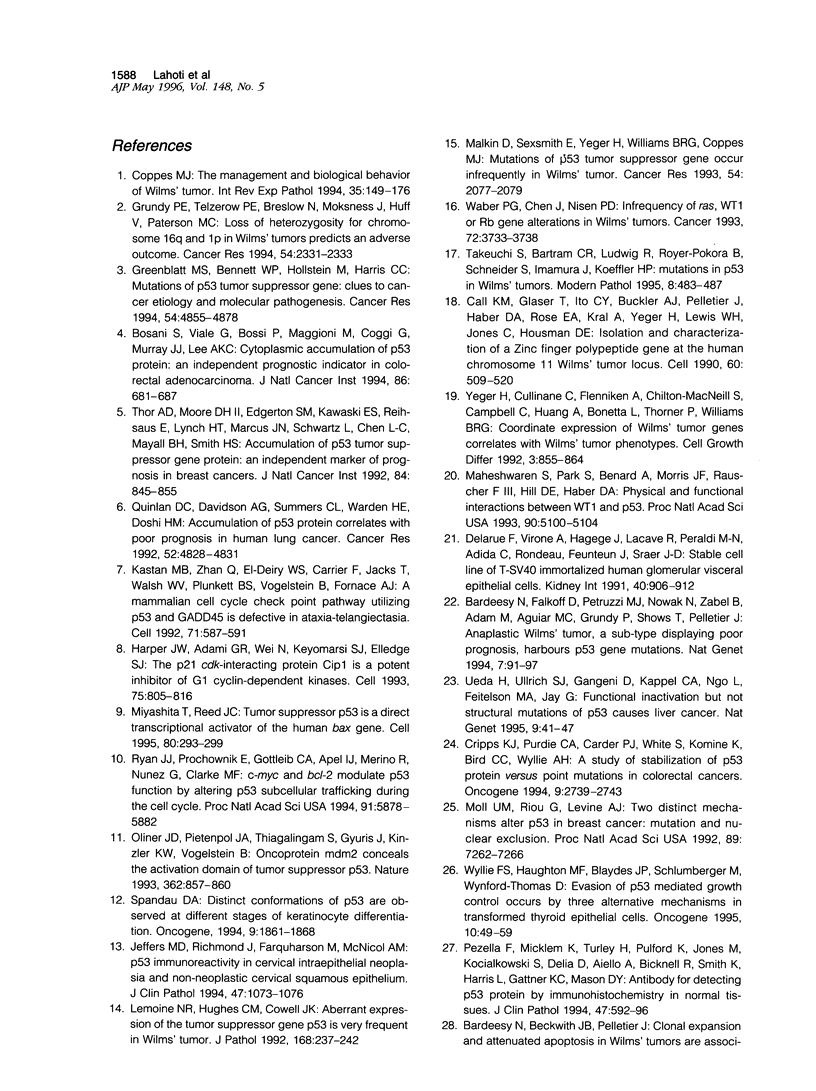

Images in this article
Selected References
These references are in PubMed. This may not be the complete list of references from this article.
- Alderson L. M., Castleberg R. L., Harsh G. R., 4th, Louis D. N., Henson J. W. Human gliomas with wild-type p53 express bcl-2. Cancer Res. 1995 Mar 1;55(5):999–1001. [PubMed] [Google Scholar]
- Bardeesy N., Falkoff D., Petruzzi M. J., Nowak N., Zabel B., Adam M., Aguiar M. C., Grundy P., Shows T., Pelletier J. Anaplastic Wilms' tumour, a subtype displaying poor prognosis, harbours p53 gene mutations. Nat Genet. 1994 May;7(1):91–97. doi: 10.1038/ng0594-91. [DOI] [PubMed] [Google Scholar]
- Bosari S., Viale G., Bossi P., Maggioni M., Coggi G., Murray J. J., Lee A. K. Cytoplasmic accumulation of p53 protein: an independent prognostic indicator in colorectal adenocarcinomas. J Natl Cancer Inst. 1994 May 4;86(9):681–687. doi: 10.1093/jnci/86.9.681. [DOI] [PubMed] [Google Scholar]
- Call K. M., Glaser T., Ito C. Y., Buckler A. J., Pelletier J., Haber D. A., Rose E. A., Kral A., Yeger H., Lewis W. H. Isolation and characterization of a zinc finger polypeptide gene at the human chromosome 11 Wilms' tumor locus. Cell. 1990 Feb 9;60(3):509–520. doi: 10.1016/0092-8674(90)90601-a. [DOI] [PubMed] [Google Scholar]
- Coopes M. J. The management and biological behavior of Wilms tumor. Int Rev Exp Pathol. 1994;35:149–176. [PubMed] [Google Scholar]
- Cripps K. J., Purdie C. A., Carder P. J., White S., Komine K., Bird C. C., Wyllie A. H. A study of stabilisation of p53 protein versus point mutation in colorectal carcinoma. Oncogene. 1994 Sep;9(9):2739–2743. [PubMed] [Google Scholar]
- Delarue F., Virone A., Hagege J., Lacave R., Peraldi M. N., Adida C., Rondeau E., Feunteun J., Sraer J. D. Stable cell line of T-SV40 immortalized human glomerular visceral epithelial cells. Kidney Int. 1991 Nov;40(5):906–912. doi: 10.1038/ki.1991.292. [DOI] [PubMed] [Google Scholar]
- Greenblatt M. S., Bennett W. P., Hollstein M., Harris C. C. Mutations in the p53 tumor suppressor gene: clues to cancer etiology and molecular pathogenesis. Cancer Res. 1994 Sep 15;54(18):4855–4878. [PubMed] [Google Scholar]
- Grundy P. E., Telzerow P. E., Breslow N., Moksness J., Huff V., Paterson M. C. Loss of heterozygosity for chromosomes 16q and 1p in Wilms' tumors predicts an adverse outcome. Cancer Res. 1994 May 1;54(9):2331–2333. [PubMed] [Google Scholar]
- Harper J. W., Adami G. R., Wei N., Keyomarsi K., Elledge S. J. The p21 Cdk-interacting protein Cip1 is a potent inhibitor of G1 cyclin-dependent kinases. Cell. 1993 Nov 19;75(4):805–816. doi: 10.1016/0092-8674(93)90499-g. [DOI] [PubMed] [Google Scholar]
- Jeffers M. D., Richmond J., Farquharson M., McNicol A. M. p53 immunoreactivity in cervical intraepithelial neoplasia and non-neoplastic cervical squamous epithelium. J Clin Pathol. 1994 Dec;47(12):1073–1076. doi: 10.1136/jcp.47.12.1073. [DOI] [PMC free article] [PubMed] [Google Scholar]
- Kastan M. B., Zhan Q., el-Deiry W. S., Carrier F., Jacks T., Walsh W. V., Plunkett B. S., Vogelstein B., Fornace A. J., Jr A mammalian cell cycle checkpoint pathway utilizing p53 and GADD45 is defective in ataxia-telangiectasia. Cell. 1992 Nov 13;71(4):587–597. doi: 10.1016/0092-8674(92)90593-2. [DOI] [PubMed] [Google Scholar]
- Lemoine N. R., Hughes C. M., Cowell J. K. Aberrant expression of the tumour suppressor gene p53 is very frequent in Wilms' tumours. J Pathol. 1992 Oct;168(2):237–242. doi: 10.1002/path.1711680213. [DOI] [PubMed] [Google Scholar]
- Maheswaran S., Park S., Bernard A., Morris J. F., Rauscher F. J., 3rd, Hill D. E., Haber D. A. Physical and functional interaction between WT1 and p53 proteins. Proc Natl Acad Sci U S A. 1993 Jun 1;90(11):5100–5104. doi: 10.1073/pnas.90.11.5100. [DOI] [PMC free article] [PubMed] [Google Scholar]
- Malkin D., Sexsmith E., Yeger H., Williams B. R., Coppes M. J. Mutations of the p53 tumor suppressor gene occur infrequently in Wilms' tumor. Cancer Res. 1994 Apr 15;54(8):2077–2079. [PubMed] [Google Scholar]
- Miyashita T., Reed J. C. Tumor suppressor p53 is a direct transcriptional activator of the human bax gene. Cell. 1995 Jan 27;80(2):293–299. doi: 10.1016/0092-8674(95)90412-3. [DOI] [PubMed] [Google Scholar]
- Moll U. M., LaQuaglia M., Bénard J., Riou G. Wild-type p53 protein undergoes cytoplasmic sequestration in undifferentiated neuroblastomas but not in differentiated tumors. Proc Natl Acad Sci U S A. 1995 May 9;92(10):4407–4411. doi: 10.1073/pnas.92.10.4407. [DOI] [PMC free article] [PubMed] [Google Scholar]
- Moll U. M., Riou G., Levine A. J. Two distinct mechanisms alter p53 in breast cancer: mutation and nuclear exclusion. Proc Natl Acad Sci U S A. 1992 Aug 1;89(15):7262–7266. doi: 10.1073/pnas.89.15.7262. [DOI] [PMC free article] [PubMed] [Google Scholar]
- Oliner J. D., Pietenpol J. A., Thiagalingam S., Gyuris J., Kinzler K. W., Vogelstein B. Oncoprotein MDM2 conceals the activation domain of tumour suppressor p53. Nature. 1993 Apr 29;362(6423):857–860. doi: 10.1038/362857a0. [DOI] [PubMed] [Google Scholar]
- Pelletier J. Molecular genetics of Wilms' tumor: insights into normal and abnormal renal development. Can J Oncol. 1994 Apr;4(2):262–272. [PubMed] [Google Scholar]
- Pezzella F., Micklem K., Turley H., Pulford K., Jones M., Kocialkowski S., Delia D., Aiello A., Bicknell R., Smith K. Antibody for detecting p53 protein by immunohistochemistry in normal tissues. J Clin Pathol. 1994 Jul;47(7):592–596. doi: 10.1136/jcp.47.7.592. [DOI] [PMC free article] [PubMed] [Google Scholar]
- Quinlan D. C., Davidson A. G., Summers C. L., Warden H. E., Doshi H. M. Accumulation of p53 protein correlates with a poor prognosis in human lung cancer. Cancer Res. 1992 Sep 1;52(17):4828–4831. [PubMed] [Google Scholar]
- Ryan J. J., Prochownik E., Gottlieb C. A., Apel I. J., Merino R., Nuñez G., Clarke M. F. c-myc and bcl-2 modulate p53 function by altering p53 subcellular trafficking during the cell cycle. Proc Natl Acad Sci U S A. 1994 Jun 21;91(13):5878–5882. doi: 10.1073/pnas.91.13.5878. [DOI] [PMC free article] [PubMed] [Google Scholar]
- Spandau D. F. Distinct conformations of p53 are observed at different stages of keratinocyte differentiation. Oncogene. 1994 Jul;9(7):1861–1868. [PubMed] [Google Scholar]
- Takeuchi S., Bartram C. R., Ludwig R., Royer-Pokora B., Schneider S., Imamura J., Koeffler H. P. Mutations of p53 in Wilms' tumors. Mod Pathol. 1995 Jun;8(5):483–487. [PubMed] [Google Scholar]
- Thor A. D., Moore DH I. I., Edgerton S. M., Kawasaki E. S., Reihsaus E., Lynch H. T., Marcus J. N., Schwartz L., Chen L. C., Mayall B. H. Accumulation of p53 tumor suppressor gene protein: an independent marker of prognosis in breast cancers. J Natl Cancer Inst. 1992 Jun 3;84(11):845–855. doi: 10.1093/jnci/84.11.845. [DOI] [PubMed] [Google Scholar]
- Ueda H., Ullrich S. J., Gangemi J. D., Kappel C. A., Ngo L., Feitelson M. A., Jay G. Functional inactivation but not structural mutation of p53 causes liver cancer. Nat Genet. 1995 Jan;9(1):41–47. doi: 10.1038/ng0195-41. [DOI] [PubMed] [Google Scholar]
- Waber P. G., Chen J., Nisen P. D. Infrequency of ras, p53, WT1, or RB gene alterations in Wilms tumors. Cancer. 1993 Dec 15;72(12):3732–3738. doi: 10.1002/1097-0142(19931215)72:12<3732::aid-cncr2820721228>3.0.co;2-u. [DOI] [PubMed] [Google Scholar]
- Wyllie F. S., Haughton M. F., Blaydes J. P., Schlumberger M., Wynford-Thomas D. Evasion of p53-mediated growth control occurs by three alternative mechanisms in transformed thyroid epithelial cells. Oncogene. 1995 Jan 5;10(1):49–59. [PubMed] [Google Scholar]
- Yeger H., Cullinane C., Flenniken A., Chilton-MacNeil S., Campbell C., Huang A., Bonetta L., Coppes M. J., Thorner P., Williams B. R. Coordinate expression of Wilms' tumor genes correlates with Wilms' tumor phenotypes. Cell Growth Differ. 1992 Dec;3(12):855–864. [PubMed] [Google Scholar]



